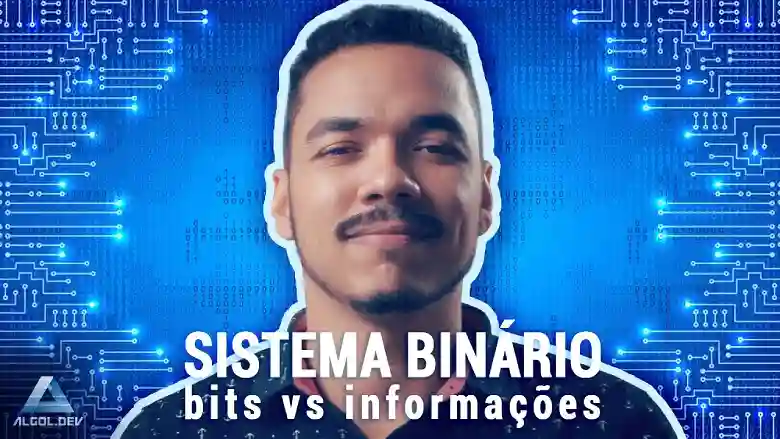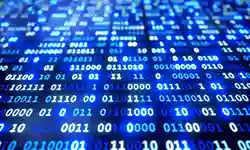Binary system: bits versus information
Understand how computers can store complex human representations in clusters of zeros and ones, through the binary system.
11/09/2023

introduction

If you are a computer user you may have wondered how they physically store all your information in a binary system. How can images so rich in color, shape and detail be loaded and interpreted from a jumble of electronically stored bits? What would be the secret behind all information representation technology by binary code?
The great secret of computing lies in the technique that exists between the simplest and most primitive representation of information (the bits) and the most complex representation of information presented to our eyes.
But how does this happen? How can data so primitively stored be interpreted as so complex and detailed human symbologies?
To understand how this happens, we must first understand why computers use the binary system to represent their information.
The limitation of the decimal number system
In our human relations we use the symbolism of numbers to represent quantities. When we want to represent an age, count product quantities, calculate cash payments or perform any kind of transaction involving values.
This symbology makes use of a system called “decimal number system” which uses ten symbols to represent quantities:

Although they are only ten symbols, they allow us to represent symbologies for all imaginable types of quantities by simply adding more symbols to the left of the representation. Notice in the illustration below how we can progress by adding more symbols to the left.

The big problem with computing is that the computer’s electronic system cannot represent these ten symbols There is no possibility to perform the calculations and operations of information electronically through any system other than the binary system.
When the computer was conceived, there was a need to use a system that could do all operations with just two symbols, because that was the maximum limit that an electronic circuit could represent (one for the PRESENCE of electric pulse and one for the ABSENCE).
The binary system of information representation
To solve the problem of not being able to use the decimal system, the Computing appropriated the “binary number system”, which is a numerical system that uses only two symbols, 0 (zero) and 1 (one), to make its representations of quantities.

Even having only two symbols, the system still allowed to represent all imaginable types of quantities. Just keep the same rule of adding more symbols to the left of the representation.
Notice in the illustration below how the binary system always allows you to progress the counting of quantities by adding more symbols to the left.

Note in the illustration above that, in the binary system, even though it is a little earlier for add new symbols to the left (when compared to the decimal system) the rule remains the same. This way, just by increasing the number more and more, we can represent all the possible quantities.
Therefore, this is how the computer can store its data and perform mathematical calculations. Using a very strange and peculiar system called “binary number system”. But we still need to understand how it can transform all this binary information into human information such as images, music, documents, etc.
Equivalence between binary and decimal system
We already understand how the decimal system and the binary information representation system work. But what is the equivalence relationship between them? How does a computer represent a specific decimal value in binary form and vice versa?
The rule is very simple, we start from the representation of the value 0 (zero) in both systems. From then on, we will progress the representation of the quantities and incrementing the symbols on the left in each of the number systems. Note that for each decimal number there is a binary representation that uses combinations of 0 (zero) and 1 (one).
| Representação no sistema decimal | Representação no sistema binário |
|---|---|
| 0 | 00000000 |
| 1 | 00000001 |
| 2 | 00000010 |
| 3 | 00000011 |
| 4 | 00000100 |
| 5 | 00000101 |
| 6 | 00000110 |
| 7 | 00000111 |
| 8 | 00001000 |
| 9 | 00001001 |
| 10 | 00001010 |
| 11 | 00001011 |
But we don’t always just use numbers! Most of the information a computer shows is textual characters, isn’t it? So what would the words in binary code look like?
The answer to this question boils down to two words: ascii table. The ascii table is a table that maps numbers to characters, so each character has a different number associated with it. For example, the letter Z (upper case) is represented in ascii table by the number 90 (decimal). And since the number 90 is represented by the number 0101 1010 in the binary system, it is easy for the computer to store it.
Below are some examples of binary representations for textual characters:
| Caractere | Número correspondente | Representação binária |
|---|---|---|
| a | 97 | 01100001 |
| b | 98 | 01100010 |
| c | 99 | 01100011 |
| d | 100 | 01100100 |
| ) | 40 | 00101000 |
| ( | 41 | 00101001 |
| * | 42 | 00101010 |
| + | 43 | 00101011 |
Now look at an example of the representation of a short sentence “Today is sunny.” in binary code.
1.01010100 01101111 01100100 01100001 01111001
2.00100000 01101001 01110011 00100000 01110011
3.01110101 01101110 01101110 01111001 00101110
These examples make it easier to understand how computers deal with human information. But there is much more complexity than that. Information representation is not limited to the ascii table and decimal to binary conversions only. There are thousands of algorithms and techniques for converting information within the binary system, such as bit-to-tone conversions (performed while reading a music file) or bit-conversion to three-dimensional scenarios (performed while playing digital games).
The important thing is to understand that computing is a recent science and each year rises several new techniques and ways to represent information.
Imagine if technology could ever evolve to the point where electronic circuits could represent more symbols and stop using the binary system? It would be a true technological revolution!
David Santiago
Master in Systems and Computing. Graduated in Information Systems. Professor of Programming Language, Algorithms, Data Structures and Development of Digital Games.